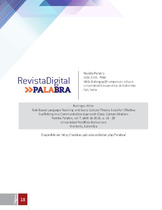Mostrar el registro sencillo del ítem
Task-Based Language Teaching and Socio Cultural Theory Basis for Effective Scaffolding in a Communicative Approach Class: Context Matters
| dc.contributor.author | Buitrago, Hilda | |
| dc.coverage.spatial | Seccional Medellín | spa |
| dc.date.accessioned | 2020-12-02T16:41:21Z | |
| dc.date.available | 2020-12-02T16:41:21Z | |
| dc.date.issued | 2018 | |
| dc.identifier.uri | http://hdl.handle.net/20.500.11912/6896 | |
| dc.description | p. 18 - 28 | spa |
| dc.description.abstract | This paper aims to present some significant concepts on Task-.Based Language teaching (TBL), Sociocultural Theory (SCT), Active Learning, Experiential Model and scaffolding that laid the theoretical framework for designing communicative tasks. More specifically, this action research focused on the creation of lesson context through the implementation of collective scaffolding strategies that would serve two equally important purposes: motivating students to take risks and increase their oral interactions, and introducing the key vocabulary they needed to carry out the successive stages and tasks of the lesson. The population catered to was made up of university students from a variety of faculties who were taking level 1 classes in an EFL communicative approach program. Different kinds of resources and mediation strategies were used. Informal visual assessment of learners’ performance and peer-teaching observations were carried out in order to compile, compare and analyze the effectiveness of the strategies and their outcomes in terms of the amount of oral production and confidence levels among the students. This peer-teaching initiative aimed at designing well-structured scaffolding an activity in which there was room for both teachers’ structured planning and students’ input. At the end of the course, informal surveys were conducted among the students to determine the overall impact of the communicative scaffolding strategy provided. Some of the benefits of combining TBL and SCT concepts to design vocabulary scaffolding tasks are described while methodological considerations for future research are provided. Theory, research and pedagogy crossed paths and merged in the design, implementation and assessment of the present action research. The main objective of the design and implementation of the vocabulary scaffolding activity described in this paper was to answer these questions: How can TBL scaffolding help increase students’ confidence and encourage them to take more risks along the lesson? What are some effective TBL scaffolding strategies that can be used to introduce a topic in an ESL class? How can effective scaffolding activities make the successive tasks more meaningful for the learners? What kind of language scaffolding can help reduce affective filters that affect students’ comprehension of the input provided in class? | spa |
| dc.format.mimetype | application/pdf | |
| dc.language.iso | eng | |
| dc.publisher | Universidad Pontificia Bolivariana | spa |
| dc.relation.ispartof | Revista Digital Palabra | spa |
| dc.rights | Attribution-NonCommercial-NoDerivatives 4.0 International | * |
| dc.rights.uri | http://creativecommons.org/licenses/by-nc-nd/4.0/ | * |
| dc.subject | Sociocultural Theory | spa |
| dc.subject | Task Based Learning | spa |
| dc.subject | Scaffolding | spa |
| dc.subject | Communicative Approach | spa |
| dc.subject | Active Learning | spa |
| dc.subject | Experiential Model | spa |
| dc.title | Task-Based Language Teaching and Socio Cultural Theory Basis for Effective Scaffolding in a Communicative Approach Class: Context Matters | spa |
| dc.type | article | spa |
| dc.rights.accessRights | openAccess | spa |
| dc.type.hasVersion | publishedVersion | spa |
| dc.description.sectional | Medellín | spa |
| dc.identifier.instname | instname:Universidad Pontificia Bolivariana | spa |
| dc.identifier.reponame | reponame:Repositorio Institucional de la Universidad Pontificia Bolivariana | spa |
| dc.identifier.repourl | repourl:https://repository.unab.edu.co/ |


